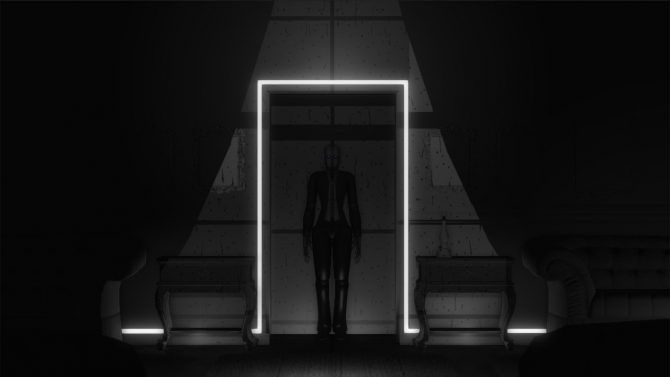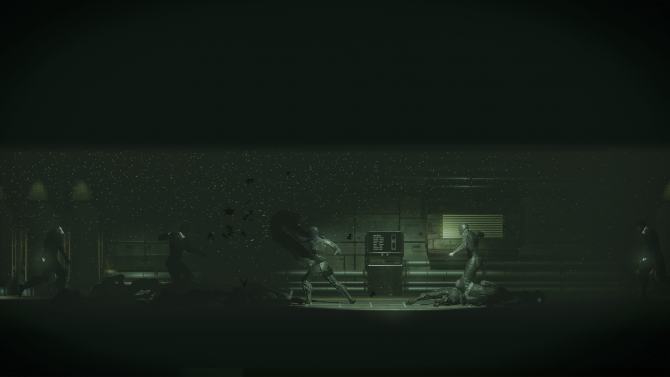In 2014, Over the Moon Games released The Fall, an action-platformer starring A.R.I.D. (an acronym forArmoured Robotics Interface Device; also spelled Arid), an A.I. onboard a combat suit housing the human pilot Colonel Josephs. Her objective is to save the pilot by any means necessary. Without spoiling anything, the game tells a clever story that will certainly surprise you by the time the credits roll. The Fall Part 2: Unbound starts right where its predecessor left off continuing Arid's journey of pushing her own programming, as well as pushing the boundaries a few other robots to help her complete her new mission: to save herself.
However, doing so will take some work. After the first game concludes — which you can watch a quick recap before you begin — the combat suit Arid is housed in is dismantled leaving her vulnerable to a virus from an unknown user. In a short series of events, you find a loophole that lets you take a physical form within a global network and trace the user's signal. Unlike the Arid in the real-world, she displays several new abilities including a higher jump, a shield that makes her invulnerable for a few seconds, and two different firing modes for her firearm.
To allow these powerful abilities to shine, gameplay within the global network is more attack-focused than any other section in the game. Unlike the original's cover-based shooting, The Fall 2: Unbound is akin to traditional side-scroll shooters with the exception of the lock-on mechanic. Additionally, the gun now has an energy meter that will overheat the firearm and deactivate your jump leaving you vulnerable to the enemy's attacks. These moments are fairly sparse and can be completed with ease but feel like filler when you encounter them. Never did I feel like I was in danger, with any death within the global network due to my impatience to get through the section as fast as possible. It's an unneeded obstacle that impedes on the interesting parts of the game like its story and puzzle-elements.
[pullquote]"The design allows you to be lazy if you are having trouble solving a particular problem."[/pullquote]
Following the user's signal will lead you to three robots: the Butler, One, and the Companion. Each one exhibits different programming that they are bound to. As an unbounded A.I., Arid hops into the consciousness of each machine in order to solve environmental puzzles to complete her own agenda. However, she still has to follow or find loopholes in the rules of each robot's programming.
While each robot has a unique personality, every section plays similarly with a few caveats. Similar to the original, you will move left or right across the screen as you explore the environment for clues or answers to the problems the robot host presents to you. You'll examine your surroundings using the robot's light source and interact with an object to potentially further your mission to find the user. I do like the idea of using a light to identify objects within the environment instead of the traditional point-and-click design this may be inspired by, but it poses a few problems.
Firstly, controlling the light with a mouse is not optimal. Not that speed or precision is needed to solve the puzzles, it was just more of a nuisance than it needed to be. Lastly, the design allows you to be lazy if you are having trouble solving a particular problem. Whenever I struggled to find a solution, I just used every tool in my inventory on the easily identifiable objects in my vicinity instead of using the clues the game gave me.
[pullquote]"Sure, the rest of the robots you meet have personalities of their own, but none of them are as engaging as the Butler in both his gameplay and story."[/pullquote]
The Butler's sequences require you to follow a specific schedule each time he is activated. In order to progress, you'll have to find ways to alter his priority to match your objective. It is in this particular section where the story and gameplay meld in the most perfect way possible. The clever banter between the Butler, Arid, and their surroundings is hilarious, grim, and thought-provoking. The puzzles exemplify the same characteristics which make each problem within the mansion fun and satisfying. Sure, the rest of the robots you meet have personalities of their own, but none of them are as engaging as the Butler in both his gameplay and story.
One is a combat robot that may be the most egotistical being in any fictional story I have ever read, watched, or played. As he constantly reminds you how distinct and awesome he is, you can't help but laugh at his pompous remarks. His sequences include another new fighting mechanic that utilizes his martial arts prowess; robotic enemies come from both sides and are defeated by simply moving in the direction they are coming from. Similar to the aforementioned fighting sequences in the global network, they feel unwarranted. Implementing a score for each encounter did make me treat each encounter seriously — even though the grade you garner isn't relevant to finishing a level — but felt as if it was included just to diversify the gameplay to some extent.
Lastly, the Companion was made to bring pleasure to its user in a mental and physical capacity. Her character focuses on compassion and is the most "human" out of all the robots. Her sequences are similar to that of the Butler's in that it is primarily puzzle-based. While the storytelling during her play time is intriguing enough to want to move forward, it lacks the uniqueness of the Butler's predicament.
While all of these robots have their own standalone story to tell, when they branch together like they do, it tells a story about boundaries and one's programming. On the surface, the thoughts and interactions each robot have don't seem unprecedented; machines are programmed to perform a specific task and will execute them to a fault. After analyzing it just a bit further, the story is very relatable and human; in the broadest way I can explain, it's about learning different emotions, as well as how they can be used to your advantage.
[pullquote]"The sequel does exemplify some of the gameplay flaws of its predecessor but tells a fantastic sci-fi tale and builds a world that I never imagined it would."[/pullquote]
After playing The Fall and seeing the words "to be continued" scroll across my screen, I was interested, but not excited. It told a good story, but its questionable gameplay and puzzle design left me cautiously optimistic. After my time with The Fall Part 2: Unbound, I am not only intrigued but eager for the series' conclusion when the third part inevitable releases. The sequel does exemplify some of the gameplay flaws of its predecessor but tells a fantastic sci-fi tale and builds a world that I never imagined it would.



